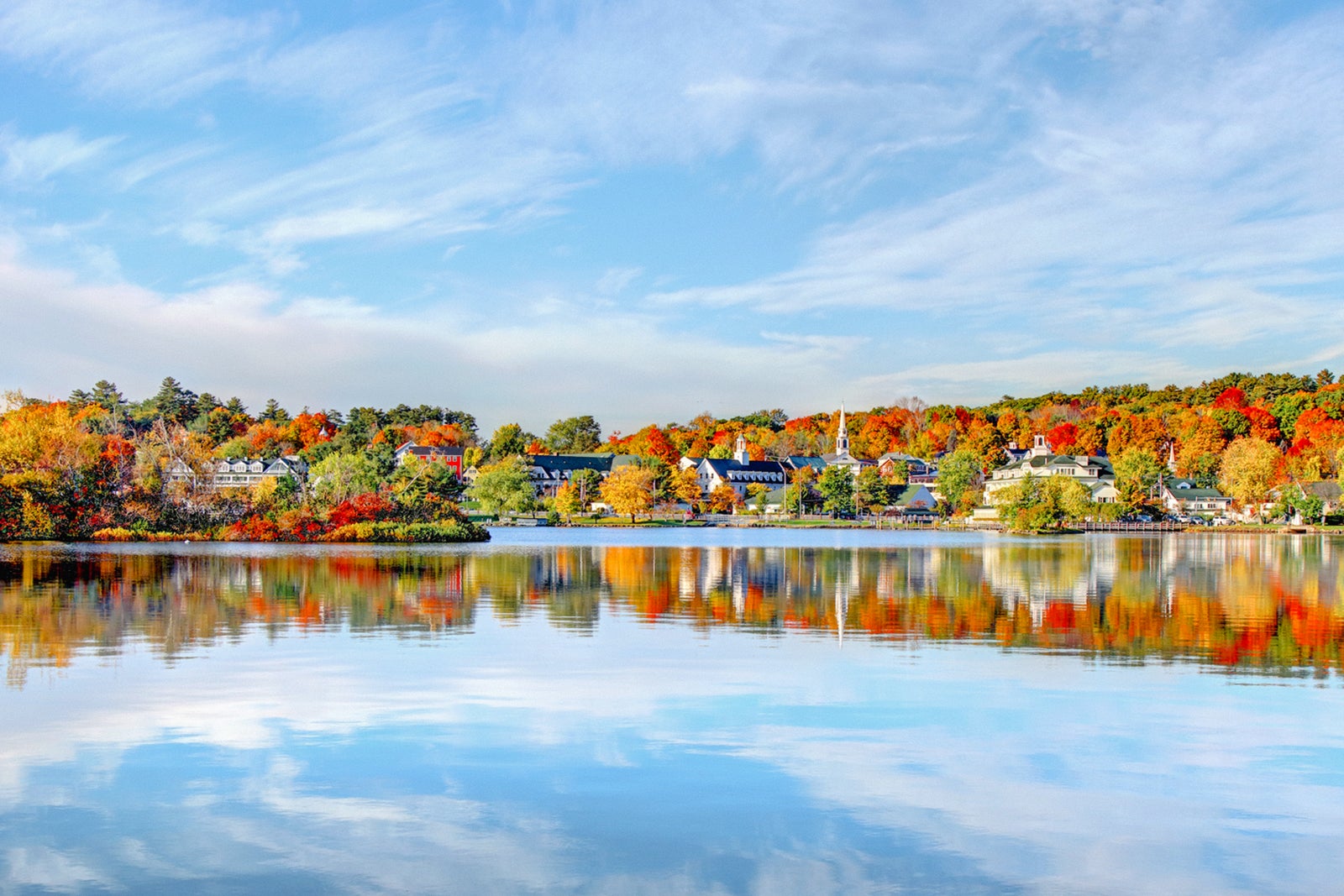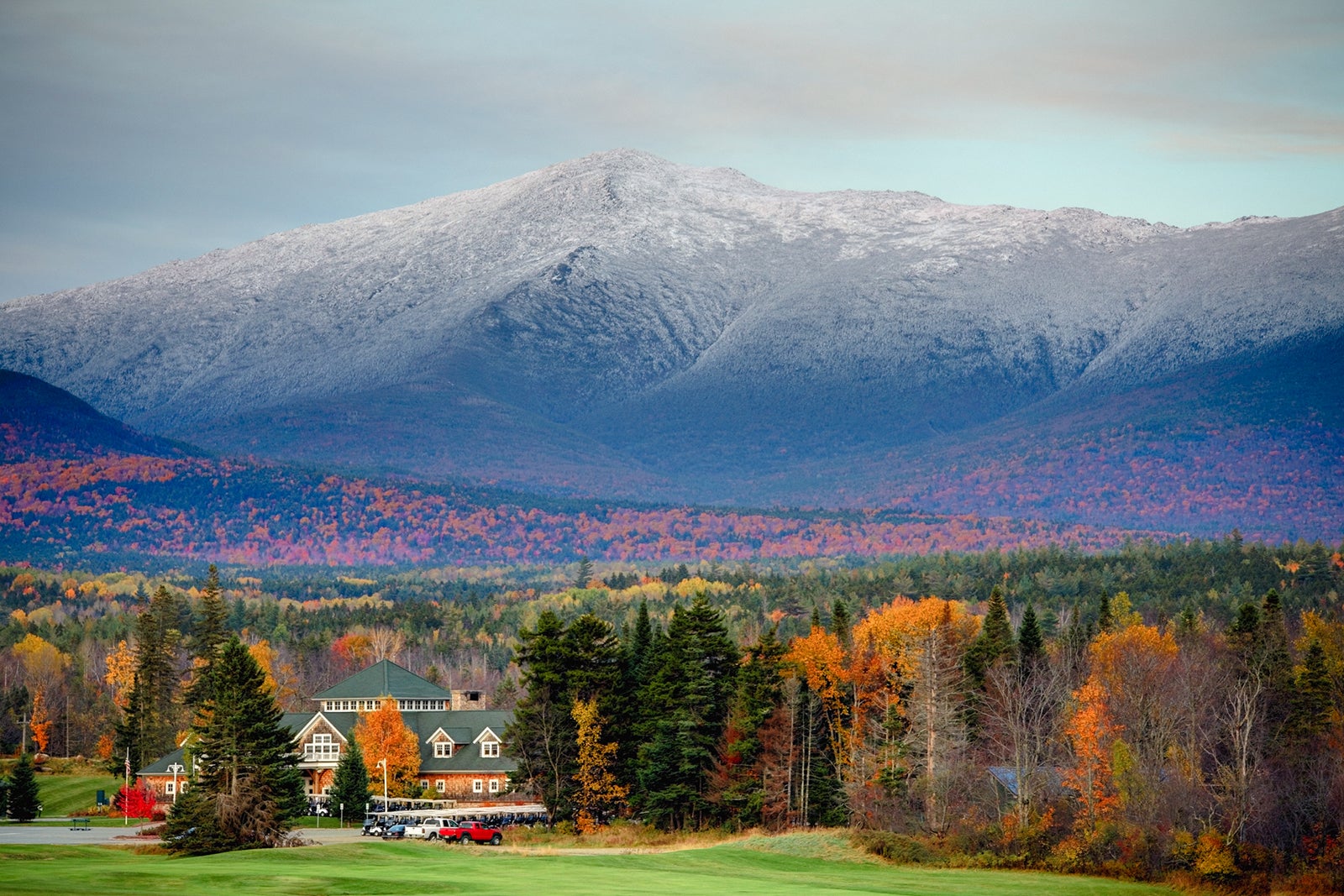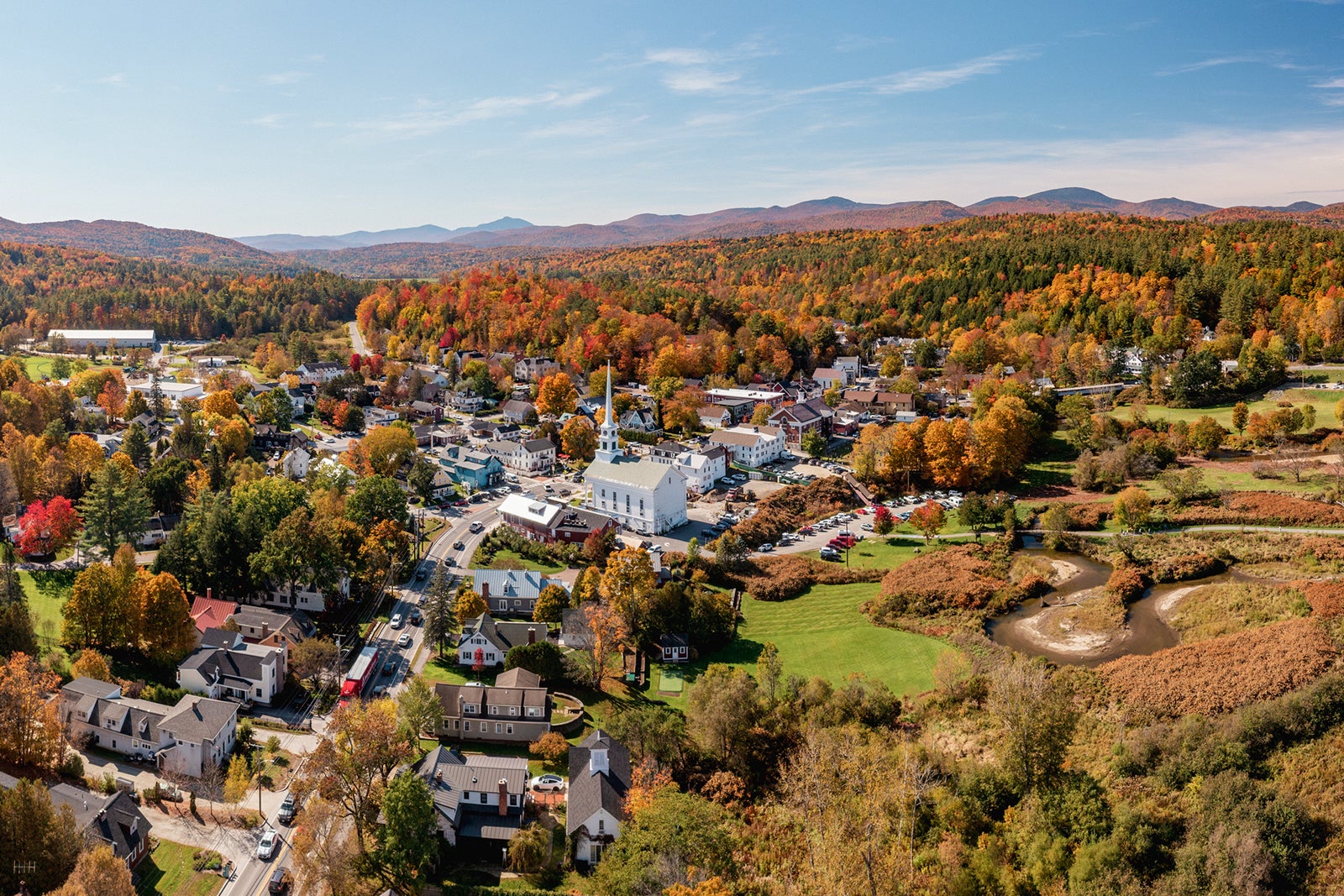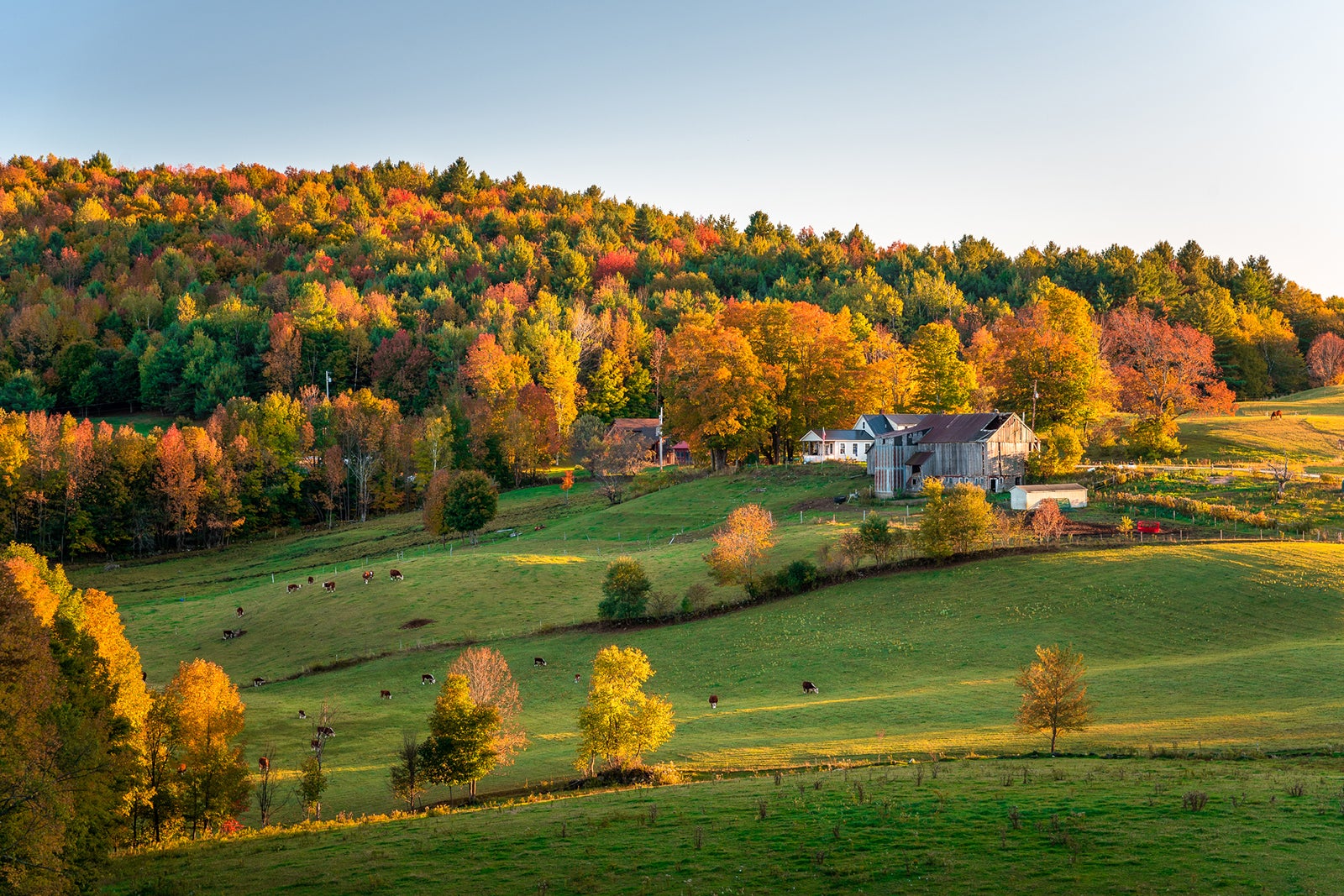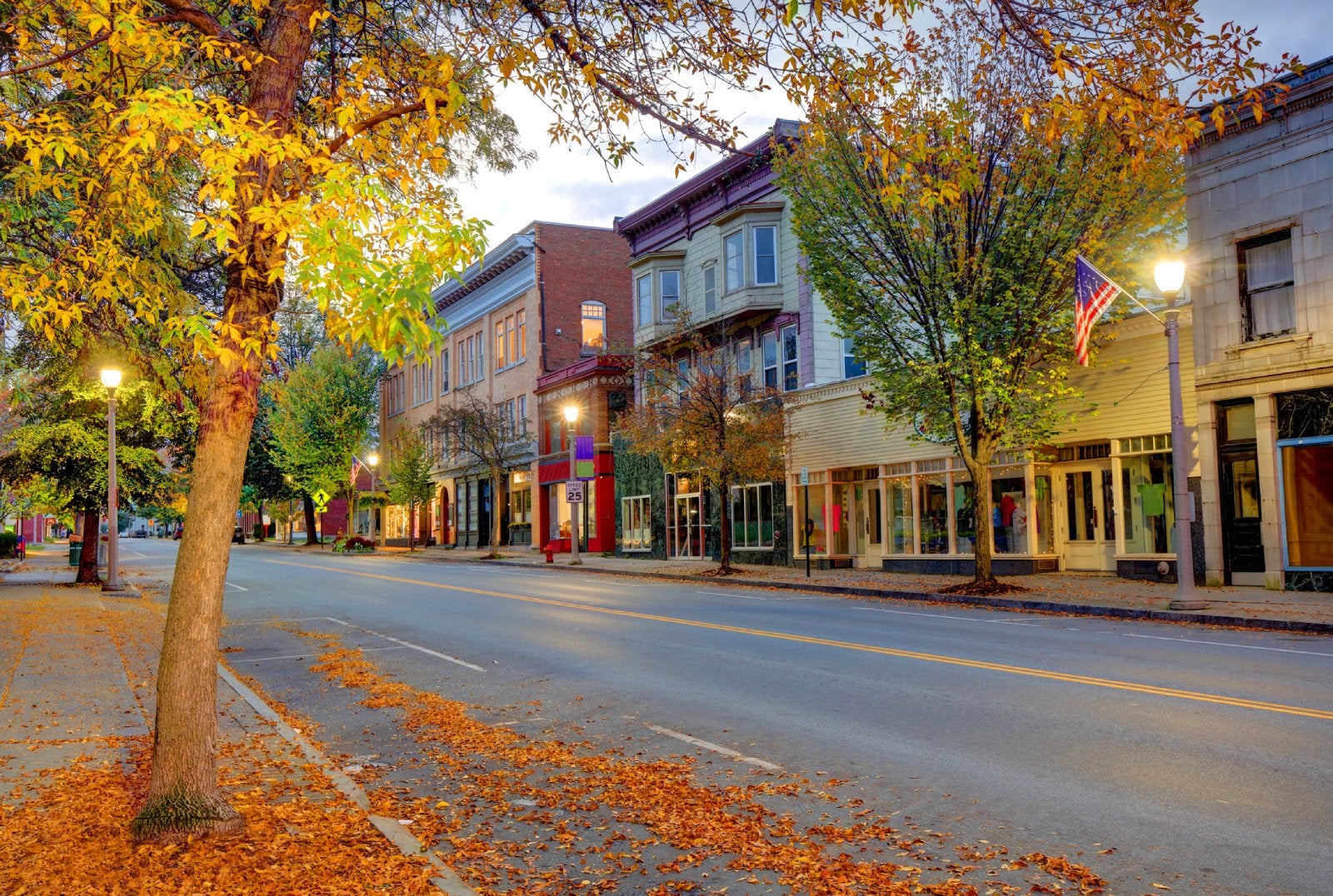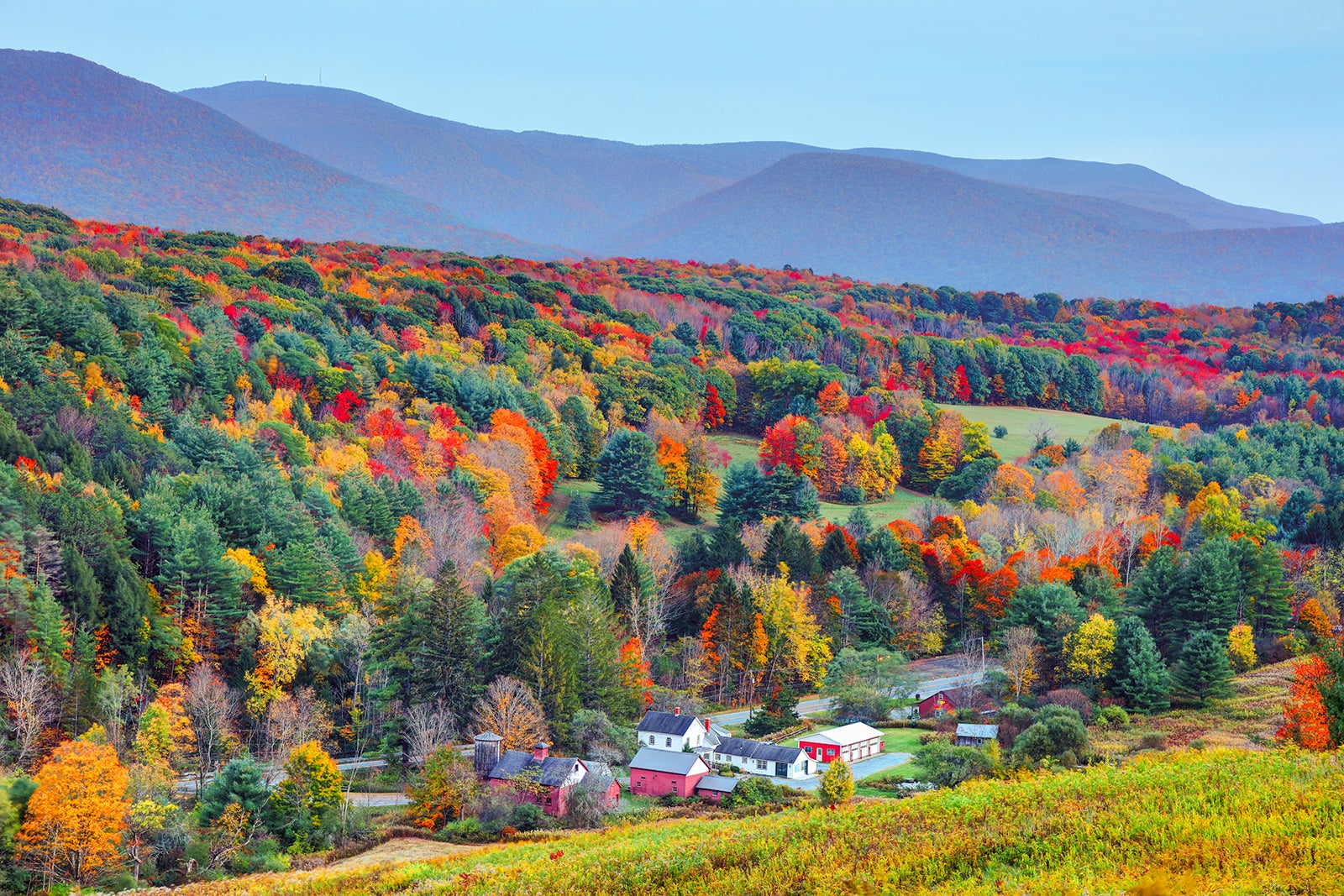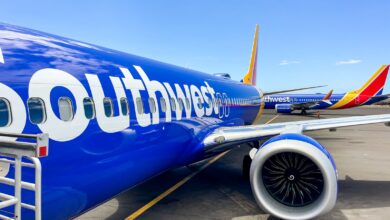Where to see the best foliage in New England this fall
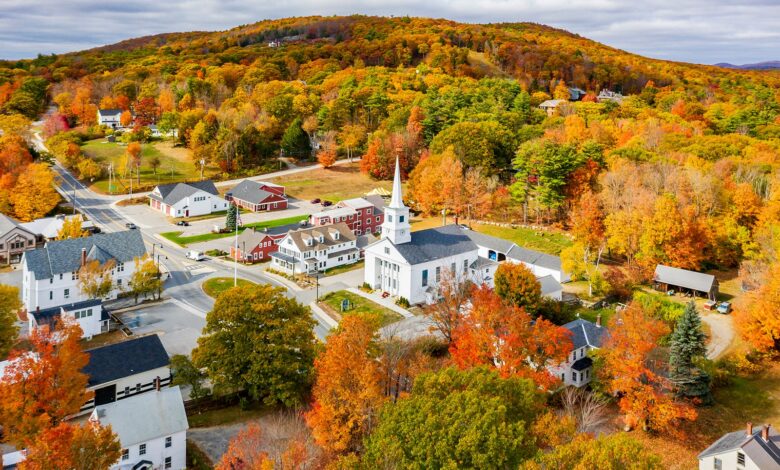
No place in the United States puts on a more breathtaking display of changing fall foliage than New England — particularly the region’s densely forested, ruggedly mountainous interior. Here, you’ll find vast forests of the trees best known for their eye-popping color: Maple trees lead the charge, but beech, birch, oak, elm, ash and willow trees also stand out for their dazzling plumage.
This New England road trip lazily meanders along country roads, crossing New Hampshire’s White Mountains, Vermont’s Green Mountains, the beautiful Berkshires of western Massachusetts and the Litchfield Hills of northwestern Connecticut.
Although this trip abounds with brilliant shades of crimson, rust, mustard and chestnut in autumn, it still offers unparalleled beauty, sophisticated dining and lodging, and a bounty of cultural diversions the rest of the year.
Planning advice
Best start and end points
This trip is lovely no matter which direction you decide to follow.
Begin in Wolfeboro, New Hampshire, on Lake Winnipesaukee and loop up through Vermont; then, zigzag your way south into western Massachusetts and end in Litchfield, Connecticut. Or, do this drive in reverse. Either way, flying into one of the several airports in southern New England allows you to drive a loop, thereby avoiding one-way car rental fees.
Bradley International Airport (BDL) in Hartford, Connecticut, is a relatively compact, user-friendly facility that’s served by most major domestic airlines. It’s less than an hour from Litchfield and 3 1/2 hours from Wolfeboro.
Another easy option is the even smaller Manchester-Boston Regional Airport (MHT). It’s just over an hour from Wolfeboro and about three hours from Litchfield. It’s served by American Airlines, Southwest Airlines, United Airlines, Avelo Airlines, Breeze Airways, JetBlue and Sun Country Airlines.
The region’s largest facility, Boston Logan International Airport (BOS), is about two hours from Wolfeboro. It offers countless direct flights, but it also tends to have higher car rental rates and requires contending with Boston’s notorious traffic.
Something of a sleeper choice, northern Vermont’s Patrick Leahy Burlington International Airport (BTV) also sits directly along the route. It’s easy to navigate and is served by most major airlines (minus Southwest and JetBlue). However, it has fewer flights per day and, generally, slightly higher fares.

Daily Newsletter
Reward your inbox with the TPG Daily newsletter
Join over 700,000 readers for breaking news, in-depth guides and exclusive deals from TPG’s experts
When to go for peak foliage viewing
The region’s foliage begins changing color earliest in northern New Hampshire and Vermont in mid-September, with the Berkshires and Litchfield Hills typically peaking closer to early October.
If you’re short on time and want the biggest bang for your buck, a good strategy is to spend the bulk of your trip in Vermont and New Hampshire during the last week of September or the first week of October.
Related: Leaf-peeping season is here: Where to see spectacular fall foliage across the US
If you have a week or more, start in New Hampshire the first week of October and gradually make your way south. You’ll encounter plenty of color up north, and you’ll continue to experience amazing color in the Berkshires and Litchfield Hills if you pass through these areas the second week of October.
Keep in mind that you will encounter steep airfare, as well as higher car-rental rates and hotel prices, during the fall foliage season.
When to visit for outdoor adventure
Thinking about making this trip during another time of year? The whole region is absolutely stunning in summer and even in late spring, a period hugely popular for hiking, boating and other outdoorsy activities. So, these periods are also considered high season price-wise.
Much of interior New England is popular for skiing and snowboarding from December through March, as well. Outside of ski areas, though, businesses sometimes shut down or reduce hours during this period, and winter driving can be treacherous. The post-foliage shoulder season (roughly mid-October through November) is a great time for scoring bargains and can still be quite beautiful — and snowy at high elevations.
Times to avoid
Whatever you do, avoid the wet, muddy early spring months of April and May (especially in Vermont and New Hampshire), which are prone to unpredictable weather and biting black flies.
Time needed to drive the route
Give yourself no fewer than five days and as many as 10 to complete this full itinerary. If you only have time for a long weekend, focus on a portion of the trip — Litchfield County and the Berkshires are easy to explore from the New York City area and Philadelphia corridor. New Hampshire and even parts of the Berkshires and Vermont are pretty accessible for weekend trips from Boston and Montreal.
Wolfeboro to Mount Washington
Wolfeboro, Alton Bay and Mount Major
Begin your trip on the southeastern shore of the largest lake in New Hampshire — Lake Winnipesaukee — in the tidy, upscale village of Wolfeboro, which has been drawing vacationers since the 1770s.
Fully leaning into its claim as the nation’s oldest resort community, the postcard-perfect town curves around a quiet bay and offers an endearing mix of neatly kept shops, galleries and eateries. The Yum Yum Shop bakery, the Wolfeboro Dockside Grille & Dairy Bar, Black’s Paper Shop and the Country Bookseller are some highlights.
As you circle counterclockwise around the southern tip of the lake, it’s fun to watch seaplanes take off from narrow Alton Bay. For a relatively easy hike with spectacular lake and forest views, you can make the 3-mile round-trip trek up a series of granite ledges to the top of 1,786-foot-tall Mount Major.
Weirs Beach and Meredith
As you continue up and around Winnipesaukee’s jagged western shore, you’ll encounter the nostalgic, family-friendly amusements of Weirs Beach and the neighboring town of Meredith. Think video arcades, candy and ice cream counters, and hot dog and burger shops. The scene can be fun or grating, depending on your tolerance for hokey diversions. Still, one worthwhile activity this time of year is taking a scenic cruise around the shoreline on the historic M/S Washington.
In Meredith, you’ll encounter a campus of popular hotels and restaurants along the lake’s edge, plus a marina where you can rent kayaks and canoes.
Holderness to Tamworth
Follow U.S. Route 3 to Holderness for a look at the smaller but arguably even more beautiful Squam Lake, which is surrounded by several inviting country inns. The lake is well-known as the filming location of the sentimental Henry Fonda and Katharine Hepburn movie “On Golden Pond.” Be sure to stroll the nature trails and admire the gardens and animal enclosures of Squam Lakes Natural Science Center.
Follow Route 113 east to Tamworth, where you can sample artisan spirits at Tamworth Distilling & Mercantile, explore the offbeat Remick Country Doctor Museum and Farm, and watch a performance at the 1931 Barnstormers Theatre (which presents first-rate plays through September).
Related: World’s best destinations to see beautiful fall foliage without the crowds
Fryeburg to Jackson
Route 16 leads north through the eastern side of New Hampshire’s fabled White Mountains, a gorgeous tract of craggy, pristine wilderness that covers about a quarter of the state. It’s home to 48 peaks with elevations greater than 4,000 feet.
If it’s the first week of October, consider making a short detour just a few miles over the Maine border to attend the bustling Fryeburg Fair, a legendary agricultural expo that dates back to 1851.
After creeping through the inevitable traffic of lively (but touristy) North Conway, continue to the utterly charming village of Jackson. Here, you’ll find an Instagram-worthy covered bridge, several excellent country inns and cozy taverns.
Mount Washington
A bit farther north, you’ll come to the tiny town of Glen, the main jumping-off point for exploring lofty Mount Washington. At 6,288 feet, the mountain is the highest peak in the Northeast. Hiking this mammoth promontory is a difficult and extremely vertical undertaking — it’s a little more than 8 miles round-trip via the shortest routes.
Through early November, weather permitting, you can drive to the top via the Mount Washington Auto Road. This 7.6-mile route twists and turns some 4,000 feet up a very narrow road and can be a test of nerves if you’re uneasy about heights. At the top, you can visit the justly named Extreme Mount Washington museum, where the strongest gust of wind ever was recorded by a weather station (231 mph in 1934).
Guided tours up the mountain in custom vans are also available, but be sure to pack extra layers, as snow is a distinct possibility even as early as September.
Where to stay
Steps from Wolfeboro’s lakefront and colorful shops and eateries, the posh Pickering House Inn (rates start at $770 per night) offers the most sophisticated accommodations on Lake Winnipesaukee. Its on-site restaurant, Pavillion Food & Spirits, turns out superb farm-to-table cuisine.
On Winnipesauke’s western shore, the town of Meredith is home to Mill Falls at the Lake (rates start at $194 per night). The resort comprises several distinct lodgings and restaurants, along with an expansive spa.
Up in the eastern White Mountains, the busy town of North Conway has plenty of hotel rooms, from budget chains to rambling Victorian inns. The village of Jackson feels more relaxed and has several upscale lodgings, including The Inn at Thorn Hill (rates start at $130 per night). The 18-room property is a short walk from one of the best dining experiences in New Hampshire: the Thompson House Eatery.
For proximity to Mount Washington, you can’t beat The Glen House (rates start at $334 per night) — a modern, eco-conscious boutique hotel at the base of the Mount Washington Auto Road.
Mount Washington to Stowe
Kancamagus Highway
Return south along Route 16 to the town of Conway, where you’ll cross over into the western side of the White Mountains via the famous Kancamagus Highway (aka Route 112, though most locals simply call it “The Kanc.”).
This tree-lined National Scenic Byway ascends through an alluring stretch of alpine scenery that’s been thankfully protected from any kind of commercial development or road signage. Try to drive this road early on a weekday to avoid heavy leaf-peeping traffic; you can break up the drive with an easy half-mile hike to refreshing Sabbaday Falls.
Lincoln, North Woodstock and Franconia Notch State Park
Route 112 continues west into a couple of family-friendly ski and recreation towns, Lincoln and North Woodstock. Their unabashedly goofy attractions — like the Lost River Gorge and Boulder Caves — have been delighting kids for generations.
Turn north onto Interstate Highway 93, which soon narrows from a typical freeway into a single scenic lane in each direction as it pierces a deep, lush valley for 8 miles within Franconia Notch State Park. There, you can hike through the dramatic Flume Gorge and view a massive granite cliff. (Until it collapsed in 2003, the cliff had a distinctive rock formation named Old Man of the Mountain. Its facelike profile still appears on New Hampshire license plates.)
Franconia, Bethlehem and Littleton
In the idyllic town of Franconia, the verdant grounds of The Frost Place museum, which honors the one-time home of American poet Robert Frost, are a fine place to take in the fall colors. The area is also home to a nearly century-old breakfast tradition, Polly’s Pancake Parlor, which doles out hefty platters of flapjacks with enticing toppings.
As you approach the Vermont border, consider stopping in two more charming villages that abound with galleries, funky shops, brewpubs and cafes. In Bethlehem, you can treat yourself to a luscious dessert at Super Secret Ice Cream. In Littleton, you can visit the stylish Schilling Beer Co. taproom for great pizza and German-style ales on a terrace overlooking the crystalline Ammonoosuc River.
Vermont’s ‘Northeast Kingdom’
As you cross the Connecticut River and enter Vermont’s sparsely populated “Northeast Kingdom,” sweeping panoramas of the state’s stunning Green Mountains range — which forms an angular 250-mile spine from north to south — lie ahead.
These forested peaks are generally lower in elevation than those in New Hampshire, but they stand out for their exceptional beauty and for the many endearing hamlets surrounding them. They are filled with quaint general stores, maple syrup-producing sugar houses, and peaceful farms and meadows.
St. Johnsbury, Montpelier and Waterbury
Make a stop in the area’s largest town, St. Johnsbury, for a walk through the pet-friendly preserve Dog Mountain, Home of Stephen Huneck Gallery, and to explore the engaging Fairbanks Museum & Planetarium.
Follow U.S. Route 2 west through a series of cute villages to Montpelier, the nation’s least populous state capital (with a little more than 8,000 residents). Then, turn northwest and parallel the Winooski River to Waterbury, home to Ben & Jerry’s very first factory. This famously socially conscious ice cream maker offers amusing factory tours that include a visit to its Flavor Graveyard (where you can lament the discontinuation of beloved concoctions like Bovinity Divinity and Holy Cannoli).
Stowe
The vibrant fall colors really burst to life as you follow Route 100 north to the classic country hamlet of Stowe, with its handsome inns, bistros and shops. Famous for skiing and snowboarding in winter and mountain biking and hiking in summer, it’s also a beautiful spot to spend an autumn day — or weekend.
In early October, it also hosts the Stowe Foliage Arts Festival. Continue north up one of the prettiest roads in the Green Mountains, Route 108, which becomes extremely narrow along a several-mile-long stretch of boulders and rocky outcroppings that lead through Smugglers’ Notch.
Related: Best family ski resorts in the US
Where to stay
In the western White Mountains, the Lincoln-Woodstock corridor has the largest selection of hotels and ski lodges. But look to the area’s smaller towns for distinctive accommodations. Sunset Hill House (rates starting at $146 per night) is a grand 1880s hotel set high on a ridge in Sugar Hill, New Hampshire, overlooking miles of mountains. The gracious Adair Country Inn and Restaurant (rates starting at $319 per night) in Bethlehem has an outstanding restaurant, clubby public spaces and fragrant country gardens.
In Stowe, Vermont, you’ll find an appealing mix of accommodations, from cozy bed-and-breakfasts to quite snazzy spa resorts. The storied Trapp Family Lodge (rates starting at $283 per night) is set on a 2,000-acre property with astounding views; it was founded more than 70 years ago by the family that inspired “The Sound of Music.” The historic Green Mountain Inn (rates starting at $160) comprises eight early 19th-century buildings in the very center of Stowe village.
Stowe to Woodstock
Burlington
Just north of Stowe, in quaint Jeffersonville, head west and then southwest through some glorious mountain passes to the state’s largest city, Burlington. The city has a population of about 45,000 people and hugs the eastern shore of Lake Champlain.
From downtown’s dapper Waterfront Park, the panoramas of New York’s soaring Adirondack Mountains are a sight to behold, especially in autumn. Burlington is a spirited, upbeat college town (home to the University of Vermont) with an exceptional restaurant scene and plenty of appealing indie boutiques, friendly bars and hip cafes.
Shelburne
U.S. Route 7 leads south through a fertile green valley to Shelburne Farms, a 1,400-acre Victorian estate with gorgeous grounds and gardens designed by Frederick Law Olmsted. It features a beloved dairy, a stately seasonal inn (rates start at $220 per night) and a restaurant. Be sure to visit the excellent Shelburne Museum, which has nearly 40 buildings transplanted here from around the state as well as a vast collection of pre-automobile-age carriages.
Clemmons Family Farm
Farther south, explore the historic buildings, art galleries, storytelling programs and agricultural operations of 148-acre Clemmons Family Farm, a highlight among the 22 sites on the state’s African American Heritage Trail and one of Vermont’s largest African American-owned farms.
Middlebury and the Green Mountains
Follow picturesque U.S. Route 7 south to the stately college town of Middlebury, with its handsome village and handful of excellent art galleries. From here, Route 125 zigzags east over the Green Mountains; there are several photogenic spots — including at Texas Falls Recreation Area and Riley Bostwick Wildlife Management Center — where you can hop out, stretch your legs and snap a photo.
Woodstock
Head south to Woodstock, one of Vermont’s most enchanting small towns. Late conservationist and philanthropist Laurence Rockefeller and his family made it a mission to preserve the town’s colonial heritage. The Rockefellers established the Marsh-Billings-Rockefeller National Historical Park, where 550 acres of gardens and carriage paths are anchored by the opulent mansion in which the Rockefellers once resided. Across the street, you can explore one of the state’s oldest working farms, the Billings Farm and Museum.
Lake Sunapee region
If you have an extra day or (ideally) two, consider detouring back across the New Hampshire border to explore the glorious Lake Sunapee region.
You can make a loop from Woodstock by driving across the dramatic Quechee Gorge and then crossing the Connecticut River into Hanover. The tree-shaded campus of Dartmouth College anchors the town with its acclaimed Hood Museum and the Hopkins Center for the Arts.
Continue southeast to the town of New London for a drive around rippling Lake Sunapee, where you can stroll through the gardens at John Hay Estate at the Fells. Head back toward Woodstock via the scenic Connecticut River village of Cornish, setting aside an hour or two to explore the stunning gardens, lawns and buildings of Saint-Gaudens National Historical Park. The famed sculptor created many of his most memorable works here.
To return to Vermont, cross the 445-foot Cornish-Windsor Bridge — the longest historic covered bridge in the country. It’s about a 20-minute drive northwest back to Woodstock.
Where to stay
Burlington has the area’s greatest concentration of lodgings, including the contemporary Hotel Vermont (rates starting at $197 per night). Many of its well-equipped rooms offer impressive vistas of Lake Champlain. Next door, have dinner at the James Beard Award-nominated Hen of the Wood.
With its fairy-tale setting on Woodstock’s classic village green and a spectacular spa, the grand Woodstock Inn & Resort (rates starting at $298 per night) offers luxe accommodations, four restaurants and a slew of activities. Across the border in New Hampshire, the Hanover Inn Dartmouth (rates starting at $229 per night) overlooks the gracious campus of Dartmouth College.
Woodstock to Williamstown
Manchester and Mount Equinox
Head west on U.S. Route 4 and Route 100A to Plymouth, then take Route 100 on a scenic journey past picturesque villages (such as Ludlow and Londonderry) and popular ski areas (Okemo and Bromley). You’ll then reach historic Manchester, one of the largest towns in southwestern Vermont. It’s home to several notable attractions, including the American Museum of Fly Fishing and Hildene, The Lincoln Family Home, which was the early-20th-century estate home of Robert Todd Lincoln — the son of Abraham Lincoln and a future statesman and railroad executive in his own right.
On your way south, make the 5.2-mile drive up stunning Skyline Drive to the peak of 3,855-foot Mount Equinox, one of the best spots in the region to admire the autumn foliage.
Arlington, Bennington and Williamstown
Continue south via slower and more scenic Route 7A rather than U.S. Route 7. You’ll enter Arlington, a relaxing village that illustrator Norman Rockwell called home for more than a decade. Rockwell depicted the community on several occasions on the covers of The Saturday Evening Post magazine.
As you approach Bennington, you’ll spy the 306-foot-tall Bennington Battle Monument high above the treetops. Take the elevator to the top for a fantastic view of the countryside and the striking campus of Bennington College. You’ll soon cross the Massachusetts border and enter the Berkshires range, an extension of the Green Mountains.
Stop in another stately collegiate community, Williamstown. It’s home to a pair of outstanding museums: the Williams College Museum of Art and the Clark Art Institute, with its sleek contemporary addition by Japanese architect Tadao Ando.
Where to stay
In Manchester, you’ll find a number of romantic accommodations, including the Kimpton Taconic Hotel (rates starting at $175 or 32,000 IHG points per night). Although it has a classic Colonial design, this three-story boutique property with a wraparound veranda and a popular gastropub offers many modern perks, including a heated plunge pool and tech-savvy rooms.
Just up the road, The Equinox Golf Resort & Spa (rates starting at $197 per night) offers a wide range of amenities, including a plush spa, a Walter Travis-designed 1920s golf course and several restaurants.
There are a few other accommodation options in town and several more — including the upscale Williams Inn (rates starting at $271 per night) — in neighboring Williamstown.
Williamstown to Litchfield
North Adams, Mount Greylock and Pittsfield
A few miles east of Williamstown, the once bustling mill town of North Adams fell on hard times in the 1980s with the closure of a major electric plant. Fifteen years later, the plant’s handsome vintage red brick buildings were reimagined as the outstanding — and enormous — Massachusetts Museum of Contemporary Art, aka Mass MoCA.
Head south on Route 8 and either drive or hike to the 3,489-foot summit of the highest point in Massachusetts, Mount Greylock. The striking Mount Greylock Veterans War Memorial Tower sits at the top.
Continue down through the region’s largest city, Pittsfield, which has a population of about 43,600. There, you can tour Arrowhead, the former home of “Moby Dick” author Herman Melville, and Hancock Shaker Village, a living museum dedicated to telling the story of this almost-extinct religious sect.
Lenox
Farther south on U.S. 7, the tony vacation town of Lenox has drawn generations of well-to-do families, many of whom built lavish summer estates during America’s Gilded Age. Some of these are now museums, including The Mount (where American novelist Edith Wharton once resided) and the Ventfort Hall Mansion and Gilded Age Museum.
Lenox is best known for two famous performing arts venues: Shakespeare and Company presents year-round plays, and Tanglewood is a 500-acre outdoor performance space and summer home to the Boston Symphony Orchestra.
Stockbridge and Great Barrington
U.S. 7 continues south through Stockbridge, home to Chesterwood — the turn-of-the-20th-century estate of sculptor Daniel Chester French. It’s also home to the Norman Rockwell Museum (the artist resided in this town for the last 25 years of his life), which contains his relocated former studio.
This colorful village is anchored by the Red Lion Inn (rates start at $125 per night); the rambling, if idiosyncratic, hotel dates back to 1773. It also inspired Arlo Guthrie’s beloved folk song “Alice’s Restaurant.”
The last major stop in the Berkshires is Great Barrington, a fashionable weekend retreat among New Yorkers and Bostonians with see-and-be-seen restaurants and trendy galleries.
Litchfield Hills
Follow Route 41 south to Salisbury, in the northwestern corner of Connecticut’s Litchfield Hills. It’s a warren of dapper villages, dense forests and small family farms that — like the neighboring Hudson River Valley — is quite popular with celebrities. (Meryl Streep, Michael J. Fox, Patti Lupone, Kevin Bacon and Dustin Hoffman currently own or have previously owned homes in the area.)
Cornwall to Litchfield
Rejoin U.S. 7, following it down through Cornwall, with its scenic covered bridge, which dates back to 1841 and crosses the serene Housatonic River. Continue to the quaint, affluent town of Kent, then along the rippling shores of Lake Waramaug. The lake’s alpine setting recalls Switzerland.
Continue into New Preston and Washington, neatly kept towns filled with fine antique shops, stylish boutiques and renowned art galleries.
Turn northeast up through the region’s cultural and spiritual heart, Litchfield, stopping for a hike amid the lush wetlands, boardwalks and bird-watching platforms of the 4,000-acre White Memorial Conservation Center.
Where to stay
An easy walk from local restaurants and shops in lovely downtown Lenox, the Hampton Terrace Inn (rates starting at $340 per night) has 14 smartly appointed rooms, many with fireplaces. You’ll find several other hotels in Lenox and along U.S. 7 as you head north into Pittsfield. Farther south, Stockbridge and Great Barrington have a good range of mostly upscale options.
In Connecticut’s Litchfield County, the White Hart Inn (rates starting at $285 per night) has a handsome setting overlooking Salisbury’s pretty town green and dates back to 1806. It contains 16 rooms plus an excellent restaurant and casual cafe.
Just south of Litchfield in Morris, Winvian Farm (rates starting at $875 per night) is definitely a splurge. However, its 18 one-of-a-kind cottages are among the most memorable accommodations in the state. There’s even one suite that’s been created from a 1968 Sikorsky helicopter.
In North Adams, the stylish The Porches Inn at Mass MoCA (rates starting at $196 per night) has been created out of a row of restored Victorian mill workers’ houses. It’s also charmingly filled with well-curated contemporary artwork, reflecting its location just across the river from Mass MoCA.
You’ll find several other high-end inns throughout the area’s towns, especially Washington and Kent. There’s a sizable selection of mostly chain hotels and motels farther south and east in a handful of small cities outside Litchfield County, including Danbury, Waterbury and Hartford.
Related reading:

